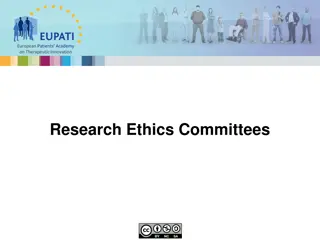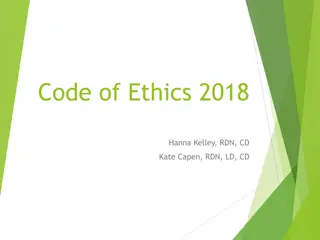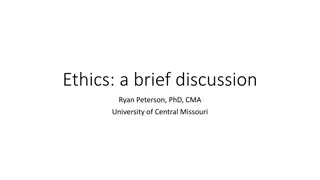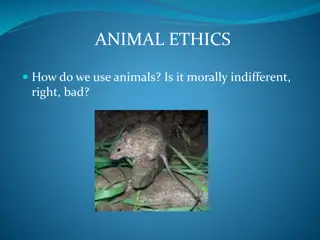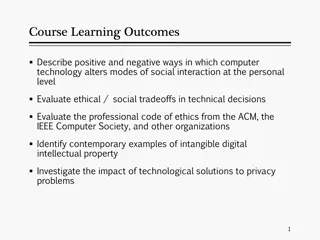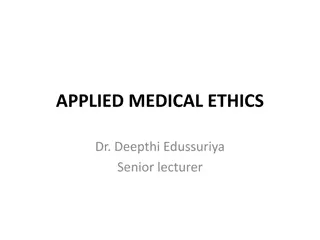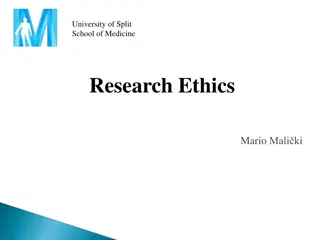Regulations and Ethics of Animal Use in Scientific Research
The use of animals in scientific research is well-regulated in the UK under the Animals (Scientific Procedures) Act 1986. This legislation aligns with the European Directive 2010/63/EU to protect animals used for scientific purposes. The Home Office issues licences to institutions and project scientists to ensure compliance with ethical standards and welfare guidelines. The Concordat on Openness in Animal Research promotes transparency and public understanding of animal research practices.
Download Presentation

Please find below an Image/Link to download the presentation.
The content on the website is provided AS IS for your information and personal use only. It may not be sold, licensed, or shared on other websites without obtaining consent from the author. Download presentation by click this link. If you encounter any issues during the download, it is possible that the publisher has removed the file from their server.
E N D
Presentation Transcript
Ethics of the Use of Animals in Scientific Research: Legislation @babrahaminst
Be able to describe how well research using animals is regulated All students will: Be able to critique non-technical summaries of research projects using animals Most students will: Be able to establish and debate their own opinion on non-technical summaries, based on an informed understanding Some students will: Concordat, AWERB, 3Rs, procedure, severity, non-technical summary Key word/s
What are your opinions on the use of animals in research? The UK has strict rules on the use of animals in scientific research NB data is from: https://www.ipsos.com/ipsos-mori/en-uk/attitudes-animal-research-2016
What are your opinions on the use of animals in research? The rules in the UK on scientific research involving animals are well-enforced NB data is from: https://www.ipsos.com/ipsos-mori/en-uk/attitudes-animal-research-2016
Concordat on Openness in Animal Research A UK agreement with over 90 signatories to share good practice and work towards transparency to help the public understand more about animal research. There are four commitments: To be clear about when, how and why we use animals in research To enhance our communications with the media and the public about our research using animals To be proactive in providing opportunities for the public to find out about research using animals To report on progress annually and share our experiences
Animals (Scientific Procedures) Act 1986 The use of animals in experiments and testing is regulated under the Animals (Scientific Procedures) Act 1986 (ASPA) ASPA has been revised to align UK law with the European Directive 2010/63/EU on the protection of animals used for scientific purposes. The revised legislation came into force on 1/1/13 ASPA is implemented by the Home Office in England, Scotland and Wales and by the Department for Health, Social Security and Public Safety in Northern Ireland.
Home Office licences required for research using animals: An Establishment Licence for the institution to ensure it has adequate facilities and staff A Project Licence for the scientist in charge of the project, which must explain how the potential medical or scientific advances to be made justify the number and type of animals and the experiments to be performed A Personal Licence for each scientist or technician who carries out any procedure
What are the principles of the 3Rs in animal research? The principles of the 3Rs were developed over 50 years ago providing a framework for performing more humane animal research. Since then they have been embedded in national and international legislation and regulations on the use of animals in scientific procedures, as well as in the policies of organisations that fund or conduct animal research. Opinion polls of public attitudes consistently show that support for animal research is conditional on the 3Rs being put into practice.
What are the principles of the 3Rs in animal research? Replacement Could any of the work be done in tissue culture or using computers? If not, could the work be done in lower species such as flies or worms? Refinement Improve animal welfare and reduce any potential suffering. Don t keep using long-established procedures without thought. Reduction Minimise the number of animals used in each experiment.
Animal Welfare and Ethical Review Body Before any decision to use animals is made, independent ethical assessments are conducted to assess if the research and procedures are justified. After local ethical review, legal authority to proceed is then sought from the Home Office, which undertakes its own assessment and decides whether to approve the research. https://www.babraham.ac.uk/our-research/animal-research/ethical- review
Animal Welfare and Ethical Review Body Review by the body compares the potential benefits of the proposed experiments with the likely costs in terms of any possible suffering. The following points are considered: Needs and benefits Costs and harms (direct) Associated harms (unrelated to the research purpose)
Non-technical Summaries Publishing non-technical summaries of licensed research projects is a legal requirement. This mandatory requirement will help put the debate on the use of animals in research and testing on a more informed footing. https://www.gov.uk/business-and-industry/animal-research-and-testing
Severity of procedures Non-recovery These are procedures that are performed entirely under general anaesthesia from which the animal will not recover consciousness. Mild Procedures as a result of which the animals are likely to experience short-term mild pain, suffering or distress, as well as procedures with no significant impairment of the well-being or general condition of the animals. Moderate Procedures as a result of which the animals are likely to experience short-term moderate pain, suffering or distress, or long-lasting mild pain, suffering or distress as well as procedures that are likely to cause moderate impairment of the well- being or general condition of the animals. Severe Procedures as a result of which the animals are likely to experience severe pain, suffering or distress, or long-lasting moderate pain, suffering or distress as well as procedures that are likely to cause severe impairment of the well-being or general condition of the animals
Activity: Review published non-technical summaries Discuss a non-technical summary in your group, including the following points: What is the reason for the research? How many animals are used? What are the severity levels? Do you understand the language used? Finally - would you have approved the project?
In Summary All animals used in research (in the UK) are protected by very strict rules Research institutions, projects, researchers and animal technicians must hold licences from the Home Office Publishing non-technical summaries of licensed research projects is a legal requirement







